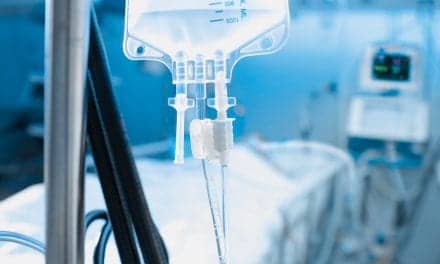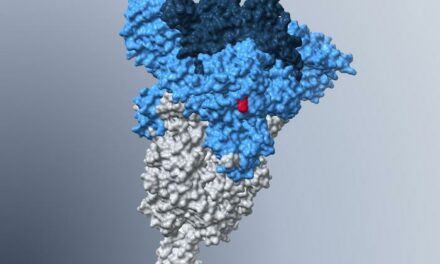Two experts on inhaled nitric oxide explain the physiological effects and properties that make iNO a potential therapeutic agent in the battle against COVID-19.
By Michael A. Gentile, MBA, RRT, FAARC, FCCM, Vero Biotech; and Jayne Prats, PhD, Vero Biotech
Nitric oxide (NO) is a ubiquitous endogenous compound that serves many functions in the human body. In respiratory and critical care, it is best known for relaxing vascular smooth muscle by increasing intracellular levels of cyclic guanosine 3’,5’- monophosphate (cGMP), which then leads to vasodilation of the pulmonary capillaries. Over twenty years ago, this function resulted in the US FDA approval of exogenous (inhaled) NO for the treatment of persistent pulmonary hypertension of the newborn (PPHN). Nitric oxide has been investigated in numerous other clinical conditions, including adult pulmonary hypertension, acute respiratory distress syndrome (ARDS), right heart failure, and in the perioperative setting for cardiothoracic surgery.
Beyond the pulmonary vasculature, however, NO is an essential signaling molecule and is involved in many important and diverse physiologic processes throughout the entire body. Interestingly, some of those well-recognized functions make inhaled nitric oxide (iNO) a candidate as a treatment option for patients infected with SARS-CoV-2. There are numerous areas in which iNO may have potential therapeutic benefit in COVID-19.
Improvement in Ventilation/Perfusion (V/Q) Matching
The physiologic effect of iNO is to provide selective pulmonary vasodilation in the capillary beds that are being oxygenated.[1] The severe pneumonia seen in patients with COVID-19 appears to interfere with pulmonary vascular regulation, with up-to-complete loss of vascular tone to vasoconstricting or vasodilating agents.[2] While many refer to acute respiratory distress syndrome (ARDS) in COVID-19, there are distinct characteristics in many patients with this infection that differ from the Berlin definition[3] of ARDS, including near-normal pulmonary compliance. In these patients, severe hypoxemia is primarily due to ventilation-perfusion (V/Q) mismatch. For this reason, high positive end-expiratory pressure (PEEP) and placing patients in the prone position are thought to improve oxygenation not through recruitment of collapsed areas, but via redistribution of pulmonary perfusion.[2] In those patients with COVID-19 who have high lung compliance, iNO may produce clinical improvement by reducing pulmonary artery pressure.
Anti-inflammatory Effect
A cytokine “storm” has been described in patients with severe COVID-19 infection.[4] Cytokine storm syndrome is an excessive immune response to external stimuli, such as sepsis, or a highly invasive viral infection. While the pathogenesis of the cytokine storm is complex, it is known to driven by inflammatory mediators that can cause rapid and severe deterioration and even death. Recent reports[5] regarding the potentially beneficial effects of dexamethasone in ICU patients with COVID-19 gives support to the concept of benefit from suppression of this highly inflammatory state. Part of the clinical manifestation of COVID-associated lung impairment is poor oxygenation due to a “thromboinflammatory” state in the lungs. In addition to a local anti-inflammatory effect in the lungs, Crawford et al have shown that iNO results in the formation of stable NO-derived products that circulate and can elicit NO-dependent signaling in extra-pulmonary tissues,[6] perhaps blunting the multi-organ effects of cytokine storm throughout the body.
Antithrombotic Effect
The thromboinflammatory condition in COVID-19 patients is linked to an unusually high incidence of thrombotic complications. Autopsies have shown widespread pulmonary thrombosis with microangiopathy in lung alveoli capillaries among COVID-19 non-survivors. To illustrate the serious nature of this complication, nine times more microthrombi were observed in COVID non-survivors compared with non-survivors of influenza A infection.[7]
While the thrombotic proclivity seen in COVID-19 syndrome is clearly multifactorial (these patients often have elevated IL-6, fibrinogen, and D-dimer levels, as well as increased C-reactive protein and erythrocyte sedimentation rate[8]), it is important to note that iNO has been associated with an antithrombotic effect via reduction of platelet aggregation in blood vessels in the lungs.[9] This effect does not appear to be dose-related, but appears to be mediated at least in part by inhibition of both P-selectin expression and fibrinogen binding to the platelet GPIIb/IIIa-receptor.[10]
Antiviral Effect
Primary among the considerations supporting a potential therapeutic role for iNO in the management of COVID-19 syndrome is the evidence for a direct antiviral effect of nitric oxide. In vitro studies have shown that NO functionally inhibits the replication of many viruses; of particular relevance, NO demonstrated an antiviral effect against the strain of coronavirus (SARS-CoV) associated with severe acute respiratory syndrome (SARS), significantly inhibiting the viral replication cycle via two separate mechanisms.[15-16] A clinical study (n=14) during the SARS epidemic in 2002-2003 showed that iNO improved oxygenation and facilitated the reduction of inspired oxygen therapy and airway pressure support in patients with severe disease.[17] Importantly, radiographic findings in the iNO-treated patients showed decreased spread or density of lung infiltrates.
Additionally, the oxygenation effects persisted after termination of iNO therapy, suggesting not only a pulmonary vasodilator effect, but also a direct effect on the SARS virus, consistent with the in vitro studies.[17] There are currently a number of iNO trials for COVID-19 listed on clinicaltrials.gov. It will be of great interest to evaluate the outcomes of these studies, and hopefully to distinguish the vasoactive effect from the antiviral effect of iNO.
iNO Administration Outside the Hospital
The COVID-19 pandemic has intensely consumed healthcare resources. The unprecedented demand has been balanced with creative solutions pioneered by clinicians. Clinical staffing, ICU beds, isolation rooms and mechanical ventilators are in particularly short supply in many areas. The use of iNO has historically been only an inpatient (mostly ICU setting) treatment option because of the reliance on compressed gas cylinders as a source of NO. The recently-FDA approved tankless system for iNO generation and delivery (GENOSYL Delivery System, Vero Biotech, Atlanta) was used in a patient with both vasoreactive pulmonary hypertension and acute COVID-19.[18] The patient was administered iNO at home, using the GENOSYL DS under an Emergency Investigative New Drug (EIND) approval for this one patient. The patient improved without any additional specific antiviral therapy and without requiring hospitalization. The COVID pandemic may ultimately serve to accelerate the use of iNO as well as other typically hospital-specific therapies into the outpatient or home environment.
In summary, inhaled nitric oxide has several long-recognized properties that make it a potential therapeutic agent in the battle against COVID-19. Multiple prospective studies are being pursued globally that may help further define the optimal role of iNO in managing COVID-19 and other viral infections.
RT
Michael A. Gentile, MBA, RRT, FAARC, FCCM, is vice president of Medical Affairs, Vero Biotech. Jayne Prats, PhD, is a consultant to Vero Biotech. For more information, contact [email protected].
Editor’s Note: The described outpatient use of iNO is an unapproved use and although positive results were observed, the US FDA has not determined that GENOSYL is a safe or effective treatment for COVID-19 syndrome.
References
- Hillman ND, Meliones JN, Black DR, Craig DM, Cheifetz IM, Smith PK. In acute lung injury, inhaled nitric oxide improves ventilation-perfusion matching, pulmonary vascular mechanics, and transpulmonary vascular efficiency. J Thorac Cardiovasc Surg. 1995;110(3):593-599; discussion 599-600. doi:10.1016/S0022-5223(95)70089-7
- Gattinoni L, Chiumello D, Rossi S. COVID-19 pneumonia: ARDS or not? Critical Care. 2020;24(1):154. doi:10.1186/s13054-020-02880-z
- Acute Respiratory Distress Syndrome: The Berlin Definition. JAMA. 2012;307(23):2526-2533. doi:10.1001/jama.2012.5669
- Ye Q, Wang B, Mao J. The pathogenesis and treatment of the `Cytokine Storm’ in COVID-19. J Infect. Published online April 10, 2020. doi:10.1016/j.jinf.2020.03.037
- Effect of Dexamethasone in Hospitalized Patients with COVID-19: Preliminary Report | medRxiv. Accessed June 28, 2020. https://www.medrxiv.org/content/10.1101/2020.06.22.20137273v1
- Crawford JH, Lang JD, Patel RP. Inhaled nitric oxide therapy for extrapulmonary inflammation. Future Science OA. 2015;1(1). doi:10.4155/fso.15.34
- Ackermann M, Verleden SE, Kuehnel M, et al. Pulmonary Vascular Endothelialitis, , Thrombosis, and Angiogenesis in Covid-19. New England Journal of Medicine. 2020doi:10.1056/NEJMoa2015432
- Connors JM, Levy JH. COVID-19 and its implications for thrombosis and anticoagulation. Blood. 2020;135(23):2033-2040. doi:10.1182/blood.2020006000
- Inhibition of Platelet Aggregation by Inhaled Nitric Oxide in Patients with Acute Respiratory Distress Syndrome | Anesthesiology | ASA Publications. Accessed June 28, 2020. https://anesthesiology.pubs.asahq.org/article.aspx?articleid=1951090
- Gries A, Herr A, Motsch J, et al. Randomized, Placebo-controlled, Blinded and Cross-matched Study on the Antiplatelet Effect of Inhaled Nitric Oxide in Healthy Volunteers. Thromb Haemost. 2000;83(2):309-315. doi:10.1055/s-0037-1613804
- Asthma and COVID-19: risks and management considerations. CEBM. Accessed June 28, 2020. https://www.cebm.net/covid-19/asthma-and-covid-19-risks-and-management-considerations/
- Growing Shortage of Albuterol Inhalers Due to COVID-19, ACAAI Advises. Drug Topics. Accessed June 28, 2020. https://www.drugtopics.com/view/growing-shortage-albuterol-inhalers-due-covid-19-acaai-advises
- Pfeffer KD, Ellison G, Robertson D, Day RW. The effect of inhaled nitric oxide in pediatric asthma. Am J Respir Crit Care Med. 1996;153(2):747-751. doi:10.1164/ajrccm.153.2.8564128
- Inhaled nitric oxide therapy in acute bronchiolitis: A multicenter randomized clinical trial | Scientific Reports. Accessed June 28, 2020. https://www.nature.com/articles/s41598-020-66433-8
- Nitric Oxide Inhibits the Replication Cycle of Severe Acute Respiratory Syndrome Coronavirus | Journal of Virology. Accessed June 28, 2020. https://jvi.asm.org/content/79/3/1966
- Akerström S, Gunalan V, Keng CT, Tan Y-J, Mirazimi A. Dual effect of nitric oxide on SARS-CoV replication: viral RNA production and palmitoylation of the S protein are affected. Virology. 2009;395(1):1-9. doi:10.1016/j.virol.2009.09.007
- Chen L, Liu P, Gao H, et al. Inhalation of Nitric Oxide in the Treatment of Severe Acute Respiratory Syndrome: A Rescue Trial in Beijing. Clin Infect Dis. 2004;39(10):1531-1535. doi:10.1086/425357
- Zamanian RT, Pollack CV Jr, Gentile MA, et al. Outpatient Inhaled Nitric Oxide in a Patient with Vasoreactive Idiopathic Pulmonary Arterial Hypertension and COVID-19 Infection. Am J Respir Crit Care Med. 2020;202(1):130-132. doi:10.1164/rccm.202004-0937LE










